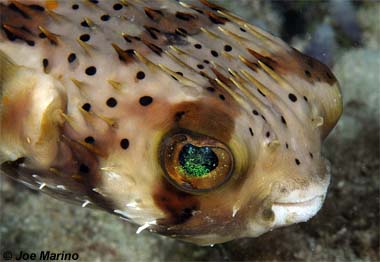
Diodon holocanthus
This slow-moving fish has small fins for navigating the shallow reefs or sea grass beds it prefers. Its teeth are formed into a beak that can crush shells of the mollusks and crustaceans it hunts at night. When threatened, it takes in water and inflates its body, making dozens of spikes stand out defensively. The balloonfish looks like similar species and can be identified by the dark blotches on its body, and the dark bars that run vertically across each eye.
Order – Tetracontiformes
Family – Diodontidae
Genus – Diodon
Species – holocanthus
Common Names
English language common names include balloonfish, balloon porcupinefish, blotched porcupinefish, brown porcupinefish, freckled porcupinefish, hedgehog fish, longsping porcupinefish, porcupinefish, and spiny puffer. Diodon holocanthus has many common names arising from the predatory defense mechanisms that the species has developed. Other language common names include areva (Tahitian), baiacu de espinho (Portuguese), ballon-penvis (Afrikaans), Botiting laot (Tagalog), boule tangue (Creole), Bunju nungu (Swahili), buntal landak (Malay), Buriring (Cebuano), cá Nóc Nhiêm (Vietnamese), harisenbon (Japanese), igelfisch (German), najezka (Polish), peixe-ouriço-de-cista (Portuguese), pejerizo balón (Spanish), porc-épine ballon (French), and tamborillo (Spanish).
Importance to Humans
They are shy creatures and will retreat if approached by a diver. In some parts of the world, the dried, inflated bodies are sold as tourist novelties. It is also used in Asian medicinal practices. The balloonfish is captured with nets and sold to the aquarium trade.
Conservation
> Check the status of the balloonfish at the IUCN website.
The IUCN is a global union of states, governmental agencies, and non-governmental organizations in a partnership that assesses the conservation status of species. The balloonfish is listed as Least Concern. The “Least Concern” listing is given when the species does not qualify for Critically Endangered, Endangered, Vulnerable or Near Threatened.
Geographical Distribution
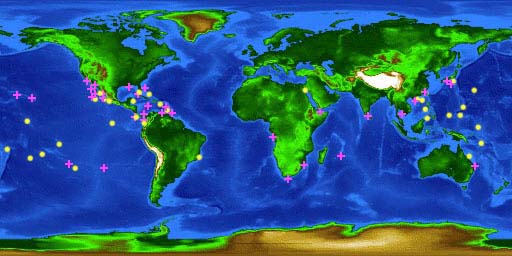
The balloonfish is found circumtropically throughout the world’s oceans, including the western Atlantic Ocean from Florida and the Bahamas, south to Brazil. It is also present in the eastern Atlantic as well as the western central and eastern Pacific Ocean.
Habitat
Adult balloonfishes occur on shallow reefs among mangroves and in open bottom areas including seagrass beds and rocky substrates. Swimming closely to the bottom, they are found at depths ranging from 6-35 feet (2-100m) below the surface of the water.
Biology
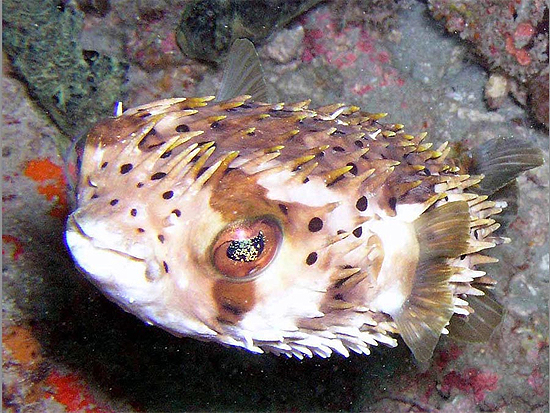
Distinctive Features
The body is covered in long, sharp spines that stick out when the fish inflates. The balloonfish inflates by taking water into its body when it is threatened. All members of the family Diodontidae are capable of inflation. Along with inflation, there may also be a color change due to the excitement.
Coloration
The balloonfish is distinguished from similar species by the large, dark blotches on the sides and back that dominate its color pattern and the small black spots interspersed between them. Unlike its relative, the porcupinefish (Diodon hystrix), these small spots do not extend onto the fins. [See Diodon key for further information.] The balloonfish has a brown bar above and below each eye. The anal, dorsal, and pectoral fins are mainly used for navigating through corals at a slow speed.
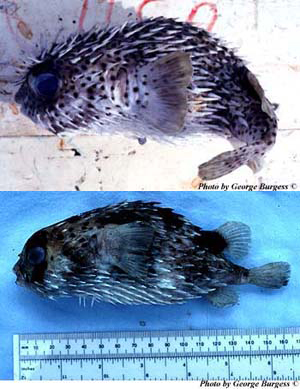
Size, Age, and Growth
This species commonly grows to lengths of 8-14 inches (20-35 cm), reaching a maximum of 20 inches (50 cm).
Food Habits
Balloonfish are nocturnal predators, generally hiding in crevices during the day. The teeth are fused together into a single unit, creating a strong, beak-like mouth capable of cracking the shells of snails, sea urchins, and hermit crabs.
Reproduction
The balloonfish has a pelagic, or open-ocean, life stage. Spawning occurs after males slowly push females to the water surface. The eggs are spherical and buoyant, floating in the water. Hatching occurs roughly after four days. The larvae are predominately yellow with scattered red spots. They are well developed with a functional mouth, eyes, and a swim bladder. Larvae less than ten days old are covered with a thin shell. After the first ten days, the shell is lost and the spines begin to develop.
The larvae undergo a metamorphosis approximately three weeks after hatching. During this time, all the fins and fin rays are present and the teeth are formed. The red and yellow colors of the larvae do not persist into the juvenile phase and are replaced by the olives and browns, characteristic of adults. Dark spots also appear on the juvenile’s underside.
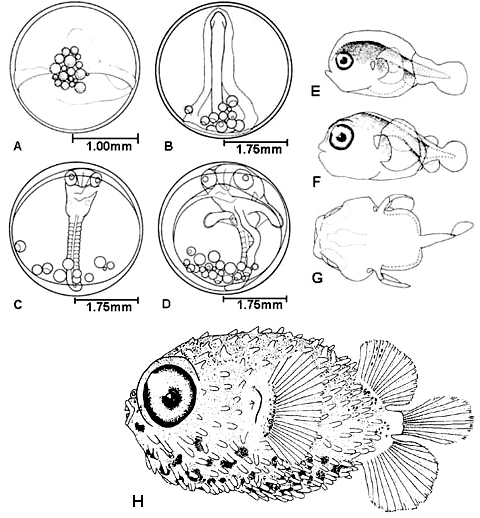
Pelagic juveniles are often associated with floating sargassum, and these spots may serve as camouflage from predators such as dolphin that swim below the seaweeds. Juveniles retain spotting until they move inshore and become adults. The juvenile balloonfish does not undergo another metamorphosis to become an adult. All changes now are external and include elongation of the spines and normal body growth.
Predators
Juvenile balloonfish are consumed by many pelagic predatory fishes, most notably tunas and dolphins. Adults fall prey to sharks.
Taxonomy
The balloonfish was first described by Linnaeus in 1758. Synonyms include Diodon pilosus Mitchell 1815, Trichodiodon pilosus Mitchell 1815, Diodon multimaculatus Cuvier 1818, and Diodon maculifer Kaup 1855, among many others. The genus Diodon is derived from the Greek words “di” = two and “odous” = teeth. The species name holocanthus is translated as entirely prickly.
Prepared by: Casey Patton